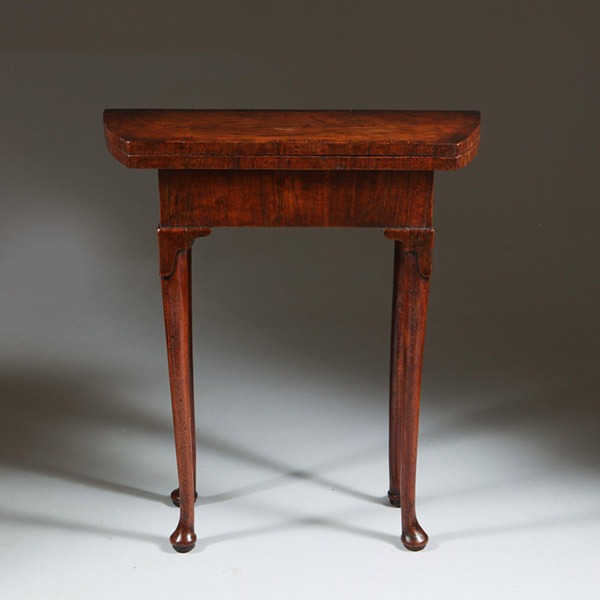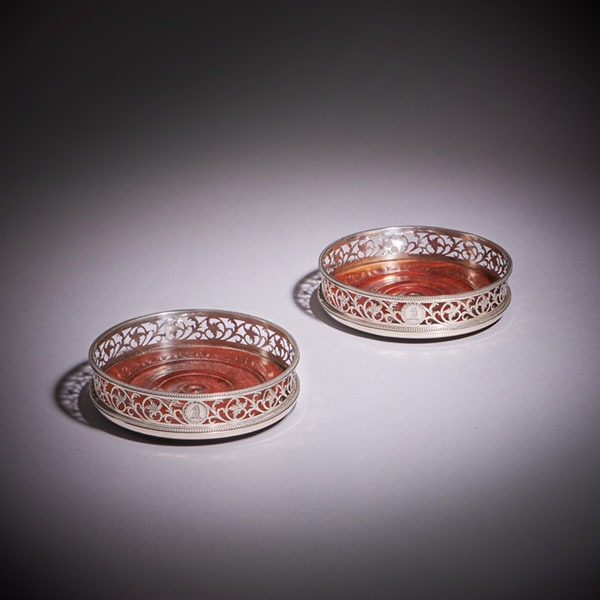Important Charles II 17th Century Princes Wood and Marquetry Longcase Clock
SOLD
Request Information
Follow Us
Important Charles II 17th Century Princes Wood and Marquetry Longcase Clock
A unique and important Charles II 17th century month-going Princes wood and floral marquetry longcase clock by the celebrated maker, John Ebsworth, circa 1685.
The case is of the highest quality decorated throughout in oysters of Princes wood and, to the face, reserves of floral marquetry depicting spring flowers, birds and grand tour vases and tazzas showing a high level of sophistication with a green glazed oval lenticle to the door. Similarly, the rising hood is decorated with an unusual gilt brass sound fret centred by a winged mask and scrolling flora, supported by prominent gilt brass Corinthian capped solid Princes wood barley twist or Solomonic columns, with glazed movement viewing windows to the sides.
The month-going six-pillar movement has going and striking trains, bolt-and-shutter maintaining power and 11-inch brass dial with a silvered chapter ring, seconds ring and date aperture. It is signed along the bottom John Ebsworth Londini Fecit.
The striking can be switched off by a silent/non-silent lever above the XII, the mechanism of which turns the bell away from the bell hammer. The middle is embellished by a superbly engraved Tudor rose on a gilt burnished circular field in the matted centre, whilst the time is indicated by a fine pair of blued-steel hands, the hour hand richly pierced.
Although this clock is exceptionally rare, and not just antique dealer ‘rare’, it is very easy to operate. Once a month you simply raise the hood, open the shutters which automatically close and wind the two trains, the left one clockwise and the right one anti-clockwise until the pulleys touch the seatboard.
John Ebsworth (1643-1699), of Cross Keys, Lothbury, London, was a pre-eminent and important early clockmaker who was appointed Master of the Clockmakers’ Company in 1697 and made a number of fine longcase, bracket and lantern clocks. This clock is an example of the fine craftsmanship of the maker and was surely commissioned by a very important client. This conclusion is informed by the choice of wood, fine movement and ornate detailing to both the longcase and movement.
Ebsworth was apprenticed to Richard Aymes on 23 February 1657, becoming free on the 3 April 1665. Ebsworth was an assistant to the Worshipful Company of Clockmakers in 1682, becoming a warden between 1694 and 1696; and finally Master in 1697.
Princes wood, also known as kingwood, was the most highly prized and expensive timber of the 17th century. Shipped in from South America by early merchants, it was only used for the finest pieces of furniture, musical instruments and occasionally clocks.
It is so rare in fact, we are only aware of one other longcase clock from the period decorated in the timber, which was almost certainly made for King Charles II of England, Ireland and Scotland, according to the paper label inside the case and spent some time in Windsor Castle. The clock in question is by Samuel Knibb and was exhibited at the ‘Innovation and Collaboration Clock Exhibition’ held at Bonhams, Bond Street, London on September 2018, Exhibit no. 51.
Another notable longcase clock by John Ebsworth is in the V&A’s collection having been bequeathed by C.D.Rotch in 1961. (Black and white Image in gallery)
Other pieces by Ebsworth can be found in the Royal Collection. Of particular interest is a Table Clock gifted to His Royal Highness The Duke of York by members of his family on the occasion of his marriage on 26 April 1923. It is situated in the Garden Room at Clarence House.
Condition
Good. Wear consistent with age and use.
Provenance
Literature
Dimensions
PREVIOUSLY SOLD
No Results Found
The page you requested could not be found. Try refining your search, or use the navigation above to locate the post.
No Results Found
The page you requested could not be found. Try refining your search, or use the navigation above to locate the post.
YOU MAY ALSO LIKE

A Unique Early 18th Century Diminutive George I Figured Walnut Bachelors Table
A Unique Early 18th Century Diminutive George I Figured Walnut Bachelors Table £12,800Follow UsA...

A Fine 18th Century George II Mahogany Marble Topped Console Table, Ireland
A Fine 18th Century George II Mahogany Marble Topped Console Table, Ireland SoldFollow UsA Fine...

A Fine Pair of 18th Century George III Silver Engraved Open Fret Wine Coasters
A Fine Pair of 18th Century George III Silver Engraved Open Fret Wine Coasters £3,600Follow UsA...

A Large 18th Century George I Gilt-Gesso Pier Glass, Attributed to John Belchier
A Large 18th Century George I Gilt-Gesso Pier Glass, Attributed to John Belchier £42,000Follow UsA...

17th Century William and Mary Floral Marquetry Olive Oyster Lace Box, Circa 1685
17th Century William and Mary Floral Marquetry Olive Oyster Lace Box, Circa 1685 £16,000Follow...

A Fine 18th Century George II Figured Walnut Chest on Chest or Tallboy, 1740
A Fine 18th Century George II Figured Walnut Chest on Chest or Tallboy, 1740 £14,000[wpforms_selector form_id="11387" _builder_version="4.22.1" _module_preset="default" custom_margin="-30px||||false|false" hover_enabled="0"...

A Unique Early 18th Century Diminutive George I Figured Walnut Bachelors Table
A Unique Early 18th Century Diminutive George I Figured Walnut Bachelors Table £12,800Follow UsA...

A Fine 18th Century George II Mahogany Marble Topped Console Table, Ireland
A Fine 18th Century George II Mahogany Marble Topped Console Table, Ireland SoldFollow UsA Fine...

A Fine Pair of 18th Century George III Silver Engraved Open Fret Wine Coasters
A Fine Pair of 18th Century George III Silver Engraved Open Fret Wine Coasters £3,600Follow UsA...

A Large 18th Century George I Gilt-Gesso Pier Glass, Attributed to John Belchier
A Large 18th Century George I Gilt-Gesso Pier Glass, Attributed to John Belchier £42,000Follow UsA...

17th Century William and Mary Floral Marquetry Olive Oyster Lace Box, Circa 1685
17th Century William and Mary Floral Marquetry Olive Oyster Lace Box, Circa 1685 £16,000Follow...

A Fine 18th Century George II Figured Walnut Chest on Chest or Tallboy, 1740
A Fine 18th Century George II Figured Walnut Chest on Chest or Tallboy, 1740 £14,000[wpforms_selector form_id="11387" _builder_version="4.22.1" _module_preset="default" custom_margin="-30px||||false|false" hover_enabled="0"...









